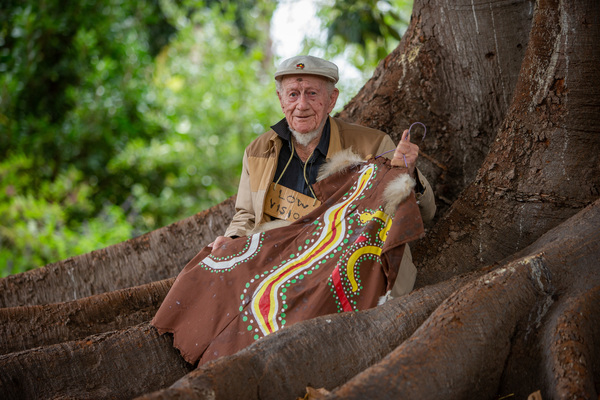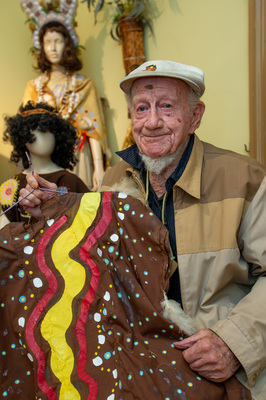
An Aboriginal elder reflects on the legacy of the memorably-named group Bunjil Aboriginal Culture and Dance Club (ACDC). It was a source of pride for him as well as its young dancers, he tells CAM LUCADOU-WELLS
For 18 years, Granddad Ewen Gardiner bestowed a great gift to an Aboriginal dance group of children.
From 1992, he founded and led the Bunjil Aboriginal Culture and Dance Club (ACDC) of Wurundjeri and other Nations.
The Dandenong-based group staged more than 250 performances. As they danced, the children proudly promoted Aboriginal culture and spirituality.
Now Grandad is 90, legally blind and lives in Springvale. And those memories, embodied in props, costumes and artefacts, have been recently on exhibition at Heritage Hill in Dandenong.
The collection includes the group’s half-metre Bunjil Eagle totem pole, and hand-painted performance costumes that depict stories of Aboriginal law and punishment, such as Willagerina Spirit Woman and the three Wanjinas.
Granddad hopes to find a place where the Bunjil ACDC group’s artefacts can be put on permanent public display.
At the moment, they are stowed in his Springvale home garage.
Bunjil ACDC started with a letter from the then-VFL. It was sent out to schools to form a group of Aboriginal dancers for Grand Final half-time entertainment.
“They had tried overseas singers from the USA, and they just turned up pissed,” he laughs.
“It had looked like they couldn’t pick a winner.”
Granddad led them through just four rehearsals at the MCG before the big day in September. It took “a lot of logistics” to keep the excited kids “contained”.
“They wanted to run all over the place,” Granddad said.
“But that went well. And after the finals, that set us going.
“I could see the potential – it was there, no worries.”
The group practised every second Sunday at the community rooms at Dandenong and District Aboriginal Co-operative. Gradually the dancers shed their natural shyness.
“It was about expressing themselves – which wasn’t really an Aboriginal trait,” Granddad says.
“They’re not really extroverts. That’s until they get the confidence – and then look out.”
They experienced some heady times, such as fronting the inaugural concert at Drum Theatre in 2006.
The group met a politically-minded Michael Jackson in his Melbourne luxury hotel who talked at length about theirs and African-Americans’ plights.
They also rubbed shoulders with Bunjil ACDC patron John Landy – an athletic great who was then Victorian Governor.
But in 2010, after 250 group performances, Granddad had to give it away. He was finding it difficult to drive the 11-seater tour bus due to his declining sight.
“It blew a head gasket, and then 12 months later it did the same thing.
“That helped me make the decision to stop.”
Since then, the bus has remained on bricks in Granddad’s driveway.
Even as a cultural leader, Granddad has had to fight doubters who say he’s not ‘black’.
He understands that his mother Beryl Gardiner was adopted out in Prahran, soon after she was born in Beechworth in 1891.
She was believed to have been fathered by an Aboriginal tracker in the area.
Catherine’s scandalised mother Lateisha Murray had been forced to give the baby up or else be ostracised from her husband Patrick and family.
Three times, Lateisha tried to return with the baby before she surrendered her, Granddad says.
His mother grew up comfortably with her adopted family. She received a good education, landing her first job at Angus and Robertson’s bookstore at the end of World War I.
Granddad’s father was a Scot who worked in Glasgow shipyards and then fought on the Western Front in the First World War.
Despite good training, his Dad struggled to find work. So like many returned British soldiers, he ventured to Australia with £10 – “a ten-pound immigrant”, Granddad says.
“They said go to buggery, go to Australia.
“War is a heartless bloody thing.”
His parents met a dance in the Flinders Street Station ballroom in central Melbourne. One of Granddad’s enduring memories was being able to feel the bullet lodged in his Dad’s abdomen.
“It didn’t hurt him but just tickled a bit.”
His father found work at Williamstown shipyards, building Corvette warships for the Australian navy before his health failed.
Granddad was a child when his father died from “complications from the war”. “It was just fatigue.”
He died at the family home – refused admission into the returned soldier’s hospital because he was British Army stock.
“It touches you to see those things – our Korean veterans and Vietnam veterans, they were pushed aside.
“They were doing it to their own poor countrymen.”
Through independent research, his nephew Sam uncovered the truth about his mother’s background many decades later.
“I’ve been carrying my mum’s blood since I was born,” Granddad says. “This gives me a chance to reply to those who say my mum wasn’t Aboriginal.”
He recites lines from a song to sum up his situation: “I know I’m a Koori.
“I’ve learnt from my kin.
“But too often I’m quiet about the colour of my skin.”







